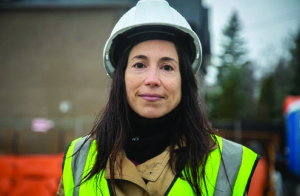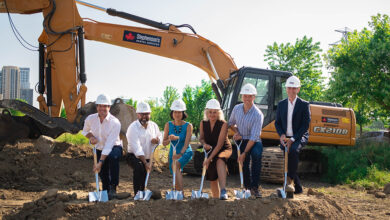Woman in construction
This year Women in Construction Week was from March 1st to March 7th. This week was aimed at breaking the stereotype that women don’t work in the construction industry. This week was founded by the National Association of Women in Construction in order to encourage more women to enter into the industry.

The construction industry is a profession that is dominated by men and the numbers of female construction workers are very low. According to Canadian statistics “in 2004, just 7% of women worked in transportation, trades and construction work” (Statistics Canada, 2005). The lack of females in the industry reinforces the belief that construction work is men’s work and women do not belong there. Despite the misconception of the construction industry being 100% male, there are some female construction workers that have made this career choice.
In celebration of this special and meaningful week, I would like to share my story as a woman in construction.
I am an occupational health and safety inspector in the construction industry. My responsibilities include site audits to ensure that construction sites as well as worker’s practices are complying with health and safety legislation. I am responsible for performing safety meetings to inform stakeholders about present issues and changes to be made concerning tasks and protocols. I am also responsible for worker training and dealings with Ministry of Labour Inspectors.
This industry is dominated by male workers who are not used to being told what to do if the advice is not coming from a tough guy. This became apparent to me as soon as I began inspecting construction sites and I began giving health and safety workshops to the workers. Being a petite, young, Latin American woman in an industry dominated by tough macho males was very challenging at the beginning. My first year working in construction was difficult because I did not fit with the usual image of what a health and safety inspector should look like in the eyes of the workers. Being female was the opposite of what everyone expected. The workers therefore ignored my health and safety advice and gave me dirty looks to make me feel as if I did not belong there.
Despite worker’s initial resistance to my presence and the advice I gave them, I have been able to succeed in performing my duties over the last 18 years. I believe that this was made possible thanks to my resilience, communication skills, and my desire to accomplish and fulfill my job responsibilities. Workers referred to me as one of them once they had accepted that I also belonged on the construction sites.
As one of the guys, I was able to cope in this environment and became very effective in performing my duties as a health and safety inspector. Still, I had to routinely over compensate to simply be respected. To prove to both workers and supervisors that I knew what I was taking about I was often expected to cite legislation from the Occupational Health and Safety Act. For example, a site supervisor was never questioned on his directions on building a home. His position alone gave him the respect and therefore he would not have to quote citations from the Building Code. I was being tested on the assumption that as a woman I was not capable of knowing health and safety construction requirements.
Despite all the hurdles I faced, I believe I have made some important changes in my workplace regarding health and safety issues and able to get workers and management on board with safety. Today, I receive a lot of positive feedback from construction workers about my training sessions and workers are often requesting that I visit their sites for advice. I have observed changes to the stereotype that women don’t work in construction, with more and more women entering into the industry. Further, it seems more of a norm to see women on a job site nowadays. If changes can be made this way, then anything is possible.
Val Ratsch/MS








Redes Sociais - Comentários